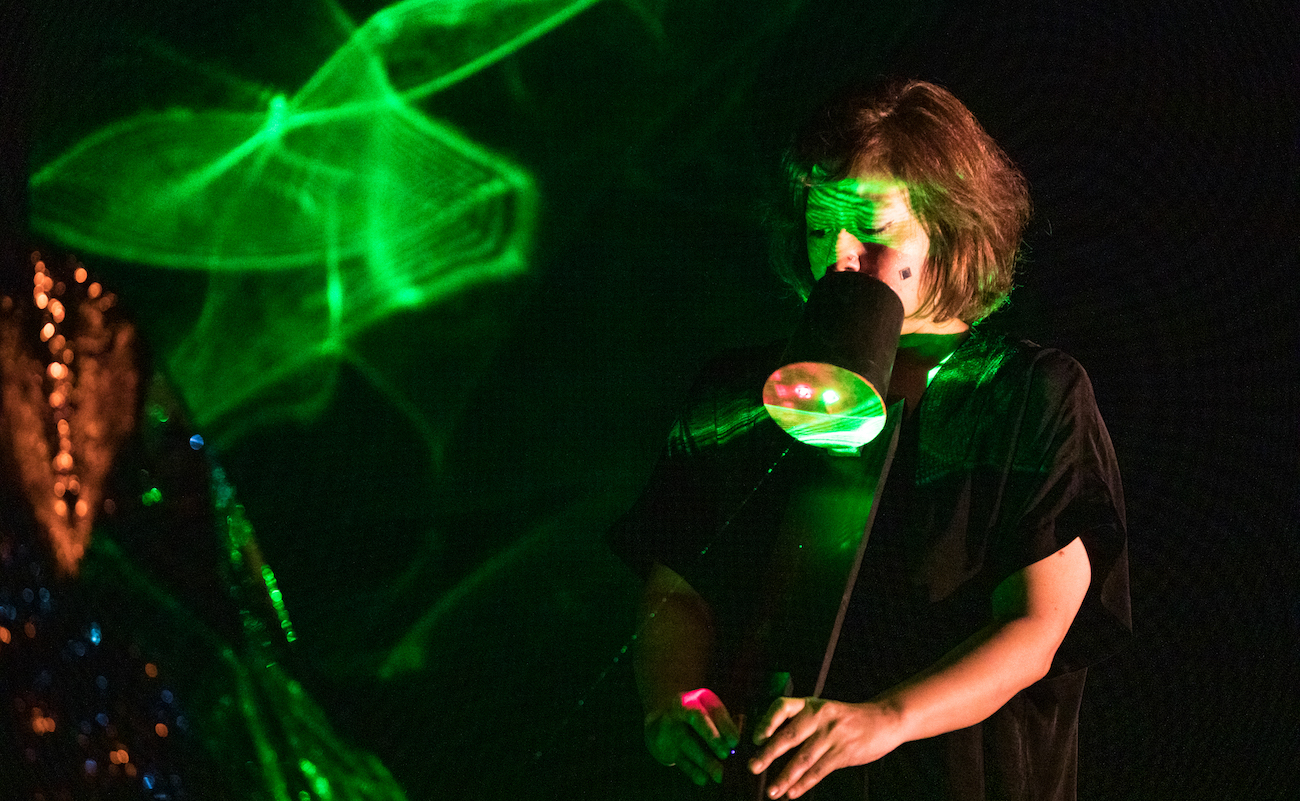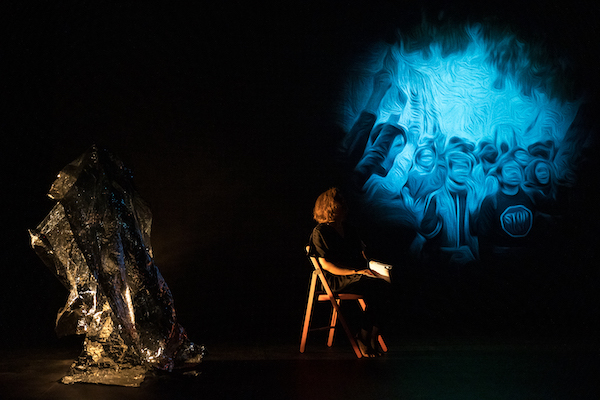Sound Can Be Silenced, If Labeled Noise: Ritika Ganguly’s Multi-Sensorial Performance is Rooted in Activism
- A 2021 McKnight Composers Fellow, she is a trained anthropologist committed to “vocabulary-building of South Asian folk music.”

I am indeed fortunate to live in a city that allows me to see amazing performances, week after week. Newest in my weekend rendezvous was stumbling on two small, but ginormous performances at an equally small performing arts center. Just off downtown Minneapolis, on Snelling Avenue, Red Eye Theater hosted, as part of its New Works 4-Week Festival at its newly minted space, two contemporary and experimental acts that literally took your breath away with its audacity, boldness of thought, voices and ideas, and artists’ who imagined something that one didn’t anticipate, nor expect. Such was the power of these two performances that one walked away stunned, at the idea of what art is capable of! It need not be an over-the-top ornamentation and richness of a Phantom of The Opera, nor the high-browed acts played at the Guthrie Theater. But what it was a multi-layer, multi-hued and multi-levels of activism, experimentation and a rigorous artistic Red Eye calls itself a vital artistic lab that supports the rigorous artistic inquiry of Minnesota artists from a broad spectrum of experiences and expression. Artist-run and intentionally modest in size, Red Eye encourages experimentation, foregrounds process, and is advocating for systemic change for the contemporary performance community in the Twin Cities.

Rooted in the core tenets of experimentation, collaboration, critical discourse, Red Eye serves as a platform for the Twin Cities’ multi-faceted contemporary performance community, a space for profound shared experiences that ignite connections between people and ideas. And a risk-taker it certainly is. From making sure it bowed its head to the Native Americans on whose land this stands on, located on unceded Dakota land in Mni Sota Makoce, where 11 sovereign nations and many other Native peoples continue to live, to lending its space to artists who otherwise would not be able to find a voice.
Nowhere else would one be able to witness such originality of idea and collaboration between the artist, the set, the moves and the narration. The first performance (three shows from June 16-18) was a solo, by the powerhouse singer, songwriter and artist Ritika Ganguly. Intriguingly titled “Eye am hear”, you knew something was up. That it would be so fascinating, I did not yet know! From the concept, voice, composition and sound design, Ganguly gave 40-45 minutes of arresting performance – ably supported by her partner in crime on the set – Zoe Cinel who also helped with the visualization and projection. Sound visualizer building was by Chris Delisle and audio engineering by Shinjan Sengupta.
I am just amazed that living for so long in the Twin Cities, I had not yet encountered Ritika and her amazing talent. You see, she is a Baul singer – yes, the hauntingly beautiful sufi folk poetry and singing from Bengal. What is more, she experiments this genre with other musical trends and creates something unique. Her voice, when you first hear it, gives you goosebumps! So powerful and so haunting it comes out from within the dark depths of the sets! An activist and a trained anthropologist (Masters & MPhil) from the prestigious Jawaharlal Nehru University (JNU – the much-hated public space for activism and new learning that the Far Right in India hate so much), Ganguly is a part of the brigade that spoke up and stood with activists and students during the Draconian days of Citizen Amendment Act and its aftermath, as well as the numerous attacks of past and present JNU leaders, intellectuals, and thinkers. She later got her PhD from University of Minnesota after moving to the USA.
She is committed to “vocabulary-building of South Asian folk music in the Twin Cities” and her work often comments on western stereotypes of South Asian musical genres and practices. When not composing or consulting, she can be found coaching her students in voice culture, ear-training, deep listening, and expressive vocalizing. Ganguly is the recipient of the prestigious 2021 McKnight Composers Fellow and was recently commissioned by the Minnesota Opera to compose a mini opera in Bengali/Bangla Xylem.
Speaking after the event, I talked to her about her show and about herself – her focus not so much on musical notations and theory, but on auditory practices that deepen our aptitude to hear and express. “What secret is at stake when one truly listens? What wider world does sound bring to the surface? How does a sound come to be designated as “noise”? How [and to whom or to what] do we attribute noisiness? Can we see silence, or the act of silencing?” Using a combination of live singing, lasers, environmental scans (her house plants and even spices from her kitchen) their smells and shadows, “eye am hear” is a multi-sensorial performance experiment that explores the formation of dialogues between an artist and her environmental space, dialogues that allow for pure moments of presence, resonance, dislocation, absence, and deep connection.
Ganguly’s performance is rooted in activism and her own degenerative eye issue – you see her left eye retina projected on the background, the blood vessels seem to expand and contract to sound and laser images. Here sound is power – it reverberates throughout the piece – first through the Baul opening plea to the universe, through Raag Bhairavi later in the piece and to the bouncing spices on the drum-like table – sound is power. Scenes of protest in India and the student activists’ images seem to dissolve within themselves, like an echo that slowly fades away! The “bulldozer politics” of India is in a way utilized to show chaos, sound and bulldozer – symbols of power, trying to silence the masses and the protests! The Immigration and Nationality Act in 1965 defined a very particular kind of relationship that South Asians could have with technology – namely well-trained professionals coming into the country helped build the Silicon Valley and other tech giants. “Hence, it is exciting to me when South Asian artists experiment with technology and subvert that script, she says.
Explaining one of key elements she has utilized in the performance, the laser, Ganguly in her own words – “The light scatter you see is triggered by voice. I’m singing into a home-made device made from a used yogurt tub with a balloon stretched out one on open end. The latex vibrates with the sound waves I’m throwing at it from the other end of the tub, and there are two laser pointers (red and green) that throw their single beams into the two mirrors on the latex membrane. When the latex vibrates with my voice, the beams form irregular and random visual patterns on the floor and wall, or wherever you’re pointing the laser at. The visualizer for this piece was Zoe Cinel’s who likes playing with Mylar, and the green northern lights type spectacle you saw was just the voice falling on the mylar and scattering the light on the floor and wall.” Such simple, everyday objects to portray complex ideas!
Similarly, utilizing spices like tapioca beads and spices from the kitchen, Ganguly allows artistic freedom to capture the pulsing spices over a hollow drum that reverberate to sounds from a speaker under it. “While I’m pouring sabudana in an irregular and random way on the drum, the beats from the soundscape and her singing coming out of the speaker vibrates the fabric stretched out on the drum and that causes the sabudana or salt or suji to arrange itself in patterns on the fabric. Using a webcam to provide a close-up live feed of these patterns layered on top of images of protestors, I wanted to show how protests can be made to look like a carnival and the real ask of the protests are drowned out by the fascist control of what sounds we are allowed to hear from these protests and what we’re permitted to see and how we’re packaged these protests.”
Ganguly at one point during the performances, reads aloud letters and poems from jailed student leaders and other intellectuals – GN Saibaba, Umar Khalild, Devangaga Kalita, Anand Teltumbde and Faiz’s verses that have recently been removed from CBSE textbooks in India because they speak of awareness of inconvenient truths and dissent. “What I’m reading is audible only in parts to the audience, because the sound of dissent or protest is put behind bars. This is the part where, as opposed to the first part of the piece where we could ‘see’ and ‘smell’ sound, we can ‘see’ silencing.”
How this piece came about is again thanks to the Covid years – after doing years of Garage Band-type events and songs digitally, “I soon realized my voice was more suited to a live audience. “Digitally, I could see the musical i8nstruments would go into the danger zone of red when my sound would peak – it was for the first time I was actually able to “see” my voice! From a soothing sound, the digital screen was telling me that my voice was entering the chaos zone. That led me to think – what is silence, dissonance and chaos. When is it too noisy, or when silence is bliss”, she says. And of course, the entire piece is sitting in a political context! When at the end of the piece, she turns the mic around towards the audience, and away from her – that was engaging the audience to see, hear and question!
The second performance was a group-led performance. Called “Sounds Inside”, it is a new movement and text-based performance piece led by writer/director/designer Kate Sutton-Johnson. In a dreamlike space, an amplified world of strange patterns and repetitions emerges, and we see multiple women experiencing disconnection and overwhelm. Absurd and irreverent, intense and dark; a nearly indecipherable media and technological landscape begins to unfold. From inside a labyrinth-like puzzle of language and fragmented memories, we see these women gradually begin to map their way back to their deepest sources of power—grounded in the earth, in relationality and in meaning. The world shapeshifts—it quiets and expands—and intimate, personal mythologies make way for a vast wilderness of feminine power.
Kuhu Singh lives in Eden Prairie, Minn., a suburb of the Twin Cities. Bidding adieu to journalism a decade ago, she nonetheless loves to write and express her very strong opinions on social media and blogs and sometimes in a few Indian publications. She is a Senior Digital Marketing Manager for a broadcast retail company. Race relations, diversity, and social issues fascinate and roil her into action. She volunteers her time with certain political organizations and community organizations.


